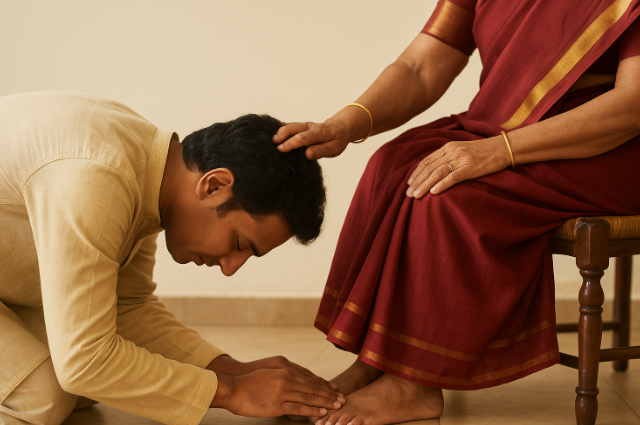
There is an old line that many of us in India grew up hearing, sometimes from a teacher, sometimes from an elder correcting us, and sometimes just written on the walls of a temple school: Mata, Pita, Guru, Daivam. Mother, father, teacher, and then God. The order is important, not casual. It is India’s way of saying that before you look up to the heavens for guidance, first recognize those who shaped you right here on earth.
Now, if you pause and think about it, this simple phrase carries a whole philosophy of how Indians have looked at life and respect for thousands of years. It is not about worshiping humans; it is about acknowledging the steps that lead you to wisdom and to the divine. You cannot reach God without first passing through the hands that raised you and the minds that taught you.
The first is always Maa. There is a reason why in most Indian languages, the word for mother is the first sound a child makes. Ma, amma, mata. The bond is primal. She is the one who carried the child in her womb, gave food before it could even chew, and gave comfort before the child even knew fear. Even today, if you look into Indian households, a mother is often the first teacher of prayers, the first one to tell stories of gods, and the first to scold when values are broken. The idea is simple — if you cannot respect the one who gave you life, how can you respect the creator of the universe?
Then comes Pita. The father’s role, especially in older traditions, was not just about earning or providing. He was the one who introduced the child to the world outside, who carried them on his shoulders to show them temples, markets, rivers, and who taught discipline in a society where rules mattered. In many scriptures, the father is also called the “upholder of dharma” for the family, the one who ensures children understand right from wrong, duty from desire. To place father second, right after mother, was India’s way of balancing nurture with structure.
The third place is the Guru. And here lies something very distinct in Indian thought. Unlike in many parts of the world where learning is mostly about classrooms or textbooks, in India, knowledge was person-centered. The guru was not only a teacher of alphabets or skills, but of life itself. Whether in music, philosophy, or even warfare, the guru was the one who gave a part of his or her own self to the disciple. That is why bowing at the guru’s feet became a tradition — not to make the teacher into a god, but to accept knowledge with humility. The line “Guru Brahma, Guru Vishnu, Guru Devo Maheshwara” was not exaggeration; it was recognition that a true guru could recreate, sustain, or transform your life like the gods themselves.
Only after these three comes Daivam, the divine. And that is the most interesting part. Indian thought does not dismiss God, but it does not rush to God either. It says — look around first, recognize the human hands that brought you here, honor them, then you are ready to
connect with what is beyond. It is almost a grounding technique to remind us that divinity is not a shortcut. Respect begins in the home, then in the classroom, then in the wider search for truth.
Of course, in modern times, some of this may feel old-fashioned. Families are changing, teachers are not always seen as gurus, and young people often find God in their own personal way. But even then, the essence of this phrase remains relevant. It tells us something we still long for — a structure of gratitude. In a world where independence is celebrated, this old order whispers gently: do not forget where you came from, do not forget the hands that fed, guided, and shaped you.
Think about it, even today, when people achieve something big, whether it’s a film star winning an award or a student topping an exam, what do they say? “I thank my parents, I thank my teachers.” And if they are spiritual, they end with “I thank God.” It is the same order, just expressed differently. That is why this little line, Mata, Pita, Guru, Daivam, has not disappeared. It still shapes how Indians think of respect and gratitude, even if unconsciously; that is the beauty of it. It is not a fixed rule that has to be followed, but it is more like a reminder. A reminder that our lives are not built alone. That before we chase the ultimate divine, we must bow to those who stood by us in flesh and blood. That divinity is not separate from human relationships; it is built upon them.
So the next time you hear the phrase, do not think of it as some moral slogan from an old textbook. Think of it as a map of reverence, starting from the mother’s lap, passing through the father’s guidance, molded by the guru’s wisdom, and finally reaching the quiet presence of God and perhaps that is why this phrase, though so simple, still carries weight in Indian households because it reminds us that gratitude is the first step towards the divine.
